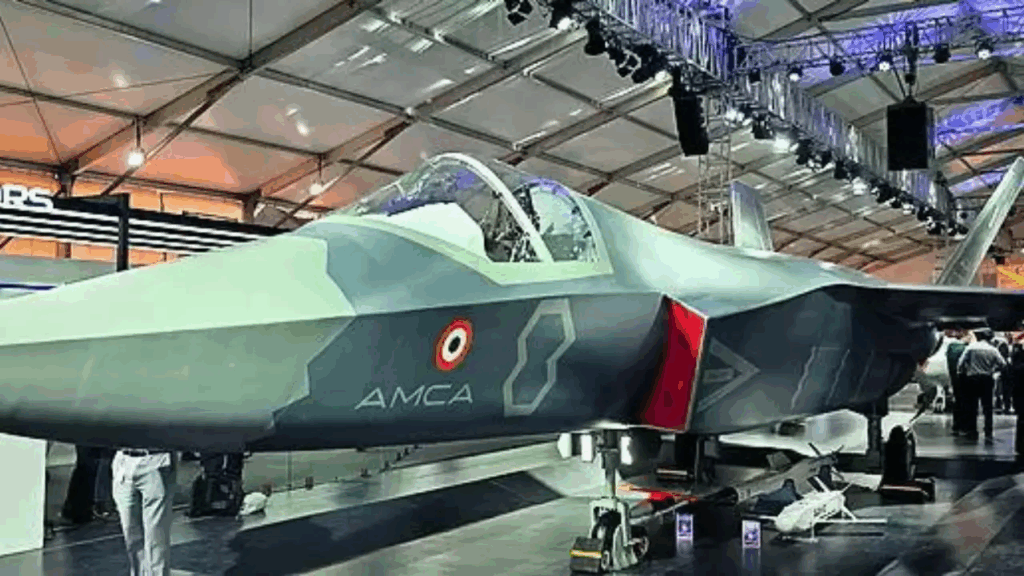India’s AMCA Stealth Fighter Jet: A New Dawn in Indigenous Airpower
Why It Is in the News
- India’s ambition to join the elite club of nations fielding fifth-generation fighter aircraft received a significant boost when Defence Minister Rajnath Singh approved the execution model of the Advanced Medium Combat Aircraft (AMCA) programme.
- This long-anticipated move officially sets in motion the country’s most sophisticated indigenous military aviation initiative to date.
- Backed by a budget exceeding ₹15,000 crore and a vision to deliver operational capability by 2035, the AMCA marks India’s definitive leap into stealth-era air combat.

Background: From Light Fighters to Stealth Machines
- India’s journey toward a fifth-generation fighter aircraft began with its experience in the Light Combat Aircraft (LCA) Tejas programme.
- While the LCA helped establish indigenous competence in jet design and avionics integration, the AMCA project is an evolutionary jump rather than a linear progression.
- Approved in principle by the Cabinet Committee on Security (CCS) in early 2024, the AMCA builds upon decades of experience gathered by institutions like the Aeronautical Development Agency (ADA) and Defence Research and Development Organisation (DRDO).
- In contrast to the LCA Mk I/II, which were fourth-generation aircraft with limited stealth and performance envelopes, AMCA aims to match or rival cutting-edge platforms like the F-35 (USA), Sukhoi Su-57 (Russia), and Chengdu J-20 (China).
Key Features and Capabilities
The AMCA is envisioned as a twin-engine, stealth-capable, multi-role fighter optimised for air superiority, deep-strike, and electronic warfare. Here are the standout features:
Stealth Design and Reduced Radar Signature
- Internal weapons bay to avoid external radar reflections
- Special radar-absorbent material (RAM) coating
- Angular, faceted surfaces for radar deflection
Advanced Digital Architecture
- Sensor Fusion: Integrated display of radar, infrared, and electronic intelligence
- AI-Driven Electronic Pilot: Decision-aid systems for reduced pilot workload
- Integrated Vehicle Health Monitoring (IVHM): Predictive diagnostics and real-time maintenance updates
High Survivability and Combat Efficiency
- Supercruise Capability: Sustained supersonic flight without afterburners
- Net-Centric Warfare Suite: Seamless coordination with UAVs, AWACS, and ground stations
- Internal Weapon Load: Up to 1,500 kg of long-range air-to-air missiles and smart munitions
- Internal Fuel Capacity: 6.5 tonnes for enhanced combat radius
- With these specifications, AMCA will offer deep-penetration strike ability, rapid engagement, and survivability in contested airspace.
Strategic Significance

The AMCA is not just another military project-it’s a strategic enabler for India’s broader objectives:
- Atmanirbhar Bharat in Defence: Reduces reliance on foreign fighters like Rafale, Su-30 MKI upgrades, or F-21 deals
- Aerospace Ecosystem Development: Encourages public-private partnerships and boosts the domestic manufacturing base
- Force Multiplication: Operates alongside Tejas Mk II, Su-30MKI, and Rafale to create a potent multi-layered air combat grid
- Geopolitical Signalling: Positions India as a technologically advanced power with indigenous stealth capability
Comparison with Global Fifth-Gen Fighters
| Parameter | AMCA | F-35(USA) | SU-75 | J-20 |
| Engine | twin | Single | Twin | Twin |
| Stealth Level | High | Very high | Moderate | High |
| Supercruise | Yes | Yes | Yes | Yes |
| Avionics | Sensor Fusion, AI | Advanced | Mixed | Advanced |
| Combat | Multi role | Multi role | Air superiority + EW | Air |
- While the AMCA may initially fall short of the F-35’s scale or the J-20’s deployment numbers, its design philosophy aligns well with India’s unique strategic and economic needs. Its compact, stealth-optimised design makes it suitable for operations over diverse terrains-from the Himalayas to the Indian Ocean.
Challenges Ahead
Engine Development
- India currently lacks a powerful, stealth-compatible jet engine. The indigenous Kaveri engine was shelved due to performance shortfalls.
- As of now, A joint venture with a foreign OEM (potentially Safran, Rolls-Royce, or GE) is being explored. The required engine must deliver high thrust, low infrared signature, and high reliability.
Timeline Pressure
- With the prototype delivery aimed for 2035, the AMCA faces a tight 10-year development windowPrevious delays in Tejas serve as a cautionary tale; timely component development and vendor integration are critical.
Industrial Collaboration
- Ensuring synergy between ADA, DRDO, HAL, and private sector players like L&T, Tata Advanced Systems, and Bharat Forge is crucial. Supply-chain bottlenecks and technology transfer hurdles could pose a delay.
Way Forward
- Strategic Partnerships for Engine and Avionics
- Fast-tracking negotiations with global OEMs for engine and radar technologies
- Ensuring technology transfer clauses that support future indigenous upgrades
- Strengthening Private Industry Role
- Opening up AMCA production under a public-private partnership (PPP) model
- Establishing Tier-1 and Tier-2 vendor ecosystems for components like composite airframes, AESA radars, and avionics modules
- Dedicated Budget and Oversight
- Ensuring the timely allocation of the ₹15,000+ crore development budget
- Appointing a single-point programme management office for progress tracking and issue resolution
Human Capital and Skill Development
- Training engineers, designers, and pilots for the fifth-generation platform handling
- Involving IAF test pilots from the early stages for continuous feedback
Conclusion: A Flight Path Toward Sovereign Airpower
The AMCA is more than a fighter jet- it represents India’s coming-of-age moment in military aviation. It is a product of strategic necessity, technological ambition, and national pride. If executed efficiently, it could make India only the fourth nation after the US, Russia, and China to field a fifth-generation stealth aircraft developed largely in-house. By 2035, as the Indian Air Force retires legacy platforms like MiG-21s and upgrades its Rafale-Su-30 mix, the AMCA will be poised to become the crown jewel of Indian airpower, symbolising a bold, self-reliant future in the face of evolving regional threats and technological frontiers.
MAINS PRACTICE QUESTION
The Advanced Medium Combat Aircraft (AMCA) programme represents a generational leap in India’s military aviation capabilities, reflecting both strategic autonomy and technological ambition.” Critically examine the key features, strategic significance, and institutional challenges of the AMCA project. How does it align with the objectives of Atmanirbhar Bharat and future-proofing India’s airpower?
(250 word)
PRELIMS PRACTICE QUESTION
Question: About India’s Advanced Medium Combat Aircraft (AMCA) project, consider the following statements:
- The AMCA is designed to operate solely in air-superiority missions and lacks deep-strike or electronic warfare capabilities.
- Unlike the Tejas Mk I/II, the AMCA is a twin-engine aircraft with supercruise capability and an internal weapons bay.
- The current indigenous engine development programme for the AMCA is spearheaded by HAL using a modified version of the Kaveri engine.
- The AMCA programme is aimed to be executed under a Public-Private Partnership (PPP) model involving both Tier-1 and Tier-2 suppliers
Which of the above statements is/are correct?
A. 2 and 4 only
B. 1, 2, and 3 only
C. 2, 3, and 4 only
D. 1 and 3 only
Correct Answer: A. 2 and 4 only
Explanation:
- Statement 1 Incorrect: AMCA is a multi-role fighter designed for air superiority, deep-strike, and electronic warfare, not solely air superiority.
- Statement 2 Correct: AMCA is twin-engine, has supercruise, and features an internal weapons bay for stealth.
- Statement 3 Incorrect: The Kaveri engine has been shelved. Current plans involve a foreign joint venture (e.g., with Safran, Rolls-Royce, or GE) for a new stealth-compatible engine, not HAL’s modified Kaveri.
- Statement 4 Correct: The AMCA programme is envisioned under a Public-Private Partnership (PPP) with a vendor ecosystem, including Tier-1 and Tier-2 suppliers like Tata, L&T, and Bharat Forge.
Also Read : Drone Technology







